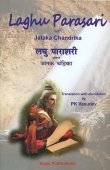Taya: 13 definitions
Introduction:
Taya means something in Hinduism, Sanskrit, Buddhism, Pali, Jainism, Prakrit, Hindi, Tamil. If you want to know the exact meaning, history, etymology or English translation of this term then check out the descriptions on this page. Add your comment or reference to a book if you want to contribute to this summary article.
In Hinduism
Vyakarana (Sanskrit grammar)
Source: Wikisource: A dictionary of Sanskrit grammarTaya (तय).—tad. affix तयप् (tayap) applied to a numeral (संख्या (saṃkhyā)) in the sense of अवयविन् (avayavin) or 'possessed of parts'; e. g. पञ्च अवयवा अस्य पञ्चतयम्, दशतयम्, चतुष्टयी (pañca avayavā asya pañcatayam, daśatayam, catuṣṭayī); cf. Kas. on P. V. 2.42. अय (aya) is substituted for तय (taya) optionally after the numerals द्वि (dvi) and त्रि (tri) and necessarily after उभ (ubha); cf. P. V. 2.43-44.

Vyakarana (व्याकरण, vyākaraṇa) refers to Sanskrit grammar and represents one of the six additional sciences (vedanga) to be studied along with the Vedas. Vyakarana concerns itself with the rules of Sanskrit grammar and linguistic analysis in order to establish the correct context of words and sentences.
Languages of India and abroad
Pali-English dictionary
Source: BuddhaSasana: Concise Pali-English Dictionarytaya : (nt.) a triad.
Source: Sutta: The Pali Text Society's Pali-English DictionaryTaya, (nt.) (Sk. trayaṃ triad, cp. trayī; see also tāvatiṃsa) a triad, in ratana-ttaya the triad of gems (the Buddha, the Norm. & the Community) see ratana; e.g. PvA. 1, 49, 141.—piṭaka-ttaya the triad of the Piṭakas SnA 328. (Page 297)

Pali is the language of the Tipiṭaka, which is the sacred canon of Theravāda Buddhism and contains much of the Buddha’s speech. Closeley related to Sanskrit, both languages are used interchangeably between religions.
Sanskrit dictionary
Source: DDSA: The practical Sanskrit-English dictionaryTaya (तय).—
1) Protection.
2) A protector; Kirātārjunīya 15.2.
Derivable forms: tayaḥ (तयः).
Source: Cologne Digital Sanskrit Dictionaries: Shabda-Sagara Sanskrit-English DictionaryTaya (तय).—mfn.
(-yaḥ-yī-yaṃ) Who or what protects. m.
(-yaḥ) Protection. E. taya, and ac aff.
Source: Cologne Digital Sanskrit Dictionaries: Monier-Williams Sanskrit-English Dictionary1) Taya (तय):—[from tay] m. [gana] vṛṣādi
2) [v.s. ...] cf. tāya.
3) Tāya (ताय):—[from tāy] m. [gana] vṛṣādi (not in [Kāśikā-vṛtti])
Source: Cologne Digital Sanskrit Dictionaries: Yates Sanskrit-English DictionaryTaya (तय):—[(yaḥ-yī-yaṃ) a.] Protecting. 1. m. Protection, defence.
[Sanskrit to German]
Sanskrit, also spelled संस्कृतम् (saṃskṛtam), is an ancient language of India commonly seen as the grandmother of the Indo-European language family (even English!). Closely allied with Prakrit and Pali, Sanskrit is more exhaustive in both grammar and terms and has the most extensive collection of literature in the world, greatly surpassing its sister-languages Greek and Latin.
Hindi dictionary
Source: DDSA: A practical Hindi-English dictionary1) Taya (तय) [Also spelled tay]:—(a) decided, settled; fixed; covered; —[karanā] to decide, to settle; to cover (as [rāstā]).
2) Tāyā (ताया):—(nm) see [tāū].
...
Prakrit-English dictionary
Source: DDSA: Paia-sadda-mahannavo; a comprehensive Prakrit Hindi dictionary1) Taya (तय) in the Prakrit language is related to the Sanskrit word: Tata.
2) Taya (तय) also relates to the Sanskrit word: Traya.
3) Tayā (तया) also relates to the Sanskrit word: Tadā.
4) Tayā (तया) also relates to the Sanskrit word: Tvac.
Prakrit is an ancient language closely associated with both Pali and Sanskrit. Jain literature is often composed in this language or sub-dialects, such as the Agamas and their commentaries which are written in Ardhamagadhi and Maharashtri Prakrit. The earliest extant texts can be dated to as early as the 4th century BCE although core portions might be older.
Tamil dictionary
Source: DDSA: University of Madras: Tamil LexiconTayā (தயா) noun < dayā. See தயவு. தாயிற் பெரி துந் தயாவுடைய தம்பெருமான் [thayavu. thayir peri thun thayavudaiya thamberuman] (திருவாசகம் [thiruvasagam] 13, 3).
Tamil is an ancient language of India from the Dravidian family spoken by roughly 250 million people mainly in southern India and Sri Lanka.
Nepali dictionary
Source: unoes: Nepali-English DictionaryTaya (तय):—adj. 1. settled; fixed; 2. concluded; ended; n. decision; settlement;
Nepali is the primary language of the Nepalese people counting almost 20 million native speakers. The country of Nepal is situated in the Himalaya mountain range to the north of India.
See also (Relevant definitions)
Starts with (+50): Tay-avalantirttan, Taya-garnu, Tayabak, Tayabas, Tayacattu, Tayaccu, Tayadara, Tayadata, Tayadati, Tayadati-pharama, Tayaguna, Tayaikkonran, Tayakaran, Tayakkam, Tayakkattai, Tayakkattam, Tayakpok, Tayal, Tayala, Tayalam.
Ends with (+297): A-lekhani-praveshataya, Abhinayacatushtaya, Adhipatiprataya, Advitaya, Aimumtaya, Aimuttaya, Ajnacatushtaya, Akuttaya, Alattaya, Amritaditrimshanmahashantaya, Amritaya, Amtashcatushtaya, Anamtaya, Anamtaya, Anandasundarisattaya, Anantacatushtaya, Aniumtaya, Aniumttaya, Anjanatritaya, Anohattaya.
Full-text (+416): Daya, Dhaya, Kharimdhama, Ashtataya, Tritaya, Thaya, Nirdayatva, Karamdhaya, Kulamdhaya, Ghatimdhaya, Nirdaya, Asyamdhaya, Nadimdhaya, Tayap, Tayam, Manaittayam, Kanittayam, Tati, Pramanta, Sadayatva.
Relevant text
Search found 98 books and stories containing Taya, Tāya, Tāyā, Tayā, Thaya, Thayaa, Daya, Dhaya; (plurals include: Tayas, Tāyas, Tāyās, Tayās, Thayas, Thayaas, Dayas, Dhayas). You can also click to the full overview containing English textual excerpts. Below are direct links for the most relevant articles:
Amaravati Art in the Context of Andhra Archaeology (by Sreyashi Ray chowdhuri)
Epigraphs from Amarāvatī (i) Monks and Nuns < [Chapter 4 - Survival of Amarāvatī in the Context of Andhra Art]
Lower Kṛṣṇā Valley (8): Nāgārjunakoṇḍa < [Chapter 2 - Amarāvatī and other Archaeological Sites of Ancient Andhra Pradesh]
Tiruvaymoli (Thiruvaimozhi): English translation (by S. Satyamurthi Ayyangar)
Pasuram 7.5.9 < [Section 5 - Fifth Tiruvaymoli (Karpar-irama-piranai)]
Mudrarakshasa (literary study) (by Antara Chakravarty)
2.15. Use of Suvadanā metre < [Chapter 4 - Employment of Chandas in Mudrārākṣasa]
2.12. Use of Pṛthvī metre < [Chapter 4 - Employment of Chandas in Mudrārākṣasa]
Rig Veda (translation and commentary) (by H. H. Wilson)
Chaitanya Bhagavata (by Bhumipati Dāsa)
Verse 1.14.186 < [Chapter 14 - The Lord’s Travel to East Bengal and the Disappearance of Lakṣmīpriyā]
Verse 3.7.139 < [Chapter 7 - Pastimes in Śrī Gadādhara’s Garden]
Verse 3.5.271 < [Chapter 5 - The Pastimes of Nityānanda]
Related products

